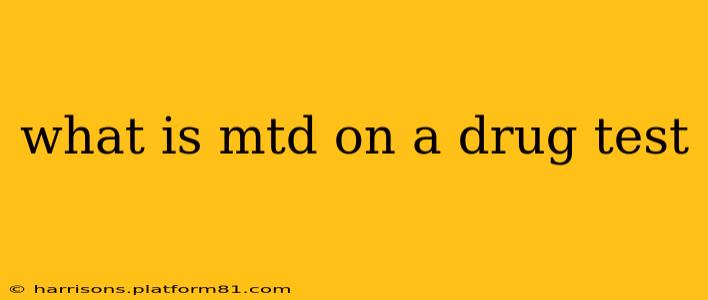Methamphetamine, a highly addictive stimulant, is frequently tested for in workplace drug screenings and legal contexts. Understanding the terminology used in these tests is crucial. MTD, in the context of a drug test, typically refers to "methamphetamine and its metabolites."
This means the test doesn't just look for methamphetamine itself, but also for the byproducts (metabolites) created by the body as it processes the drug. These metabolites can remain detectable in the system for a longer period than the parent drug, methamphetamine. Detecting metabolites significantly increases the accuracy and effectiveness of the test.
What are the Metabolites of Methamphetamine?
The primary metabolite of methamphetamine is amphetamine. Amphetamine is a similar stimulant drug, and its presence indicates recent methamphetamine use, even if the methamphetamine itself has been mostly eliminated from the body. The testing method used will determine precisely which metabolites are analyzed.
How Long Does Methamphetamine Stay in Your System?
The length of time methamphetamine and its metabolites remain detectable varies depending on several factors:
- Frequency of use: Regular users will test positive for a longer duration.
- Amount used: Larger doses will remain detectable longer.
- Metabolism: Individual metabolic rates influence how quickly the body processes the drug.
- Testing method: Different tests have varying sensitivities and detection windows. Urine tests, for example, generally detect methamphetamine and amphetamine for several days, but hair follicle testing can detect them for much longer periods—potentially up to 90 days.
It's important to note that these are general ranges, and individual results can vary.
What Does a Positive MTD Result Mean?
A positive MTD result on a drug test indicates the presence of methamphetamine or its metabolites in the sample. This usually signifies recent use of methamphetamine. The specific cutoff levels vary depending on the testing laboratory and the context of the test (e.g., workplace versus legal). A positive result may have significant consequences, including job loss, legal penalties, or mandated rehabilitation programs.
Can You Get a False Positive for MTD?
While rare, false positives are possible. Certain medications and substances can interfere with the test results, leading to an inaccurate positive result. It's crucial to disclose all medications and supplements to the testing facility. If a positive result is unexpected, seeking clarification and potentially further testing is essential.
What are the Different Types of Drug Tests for Methamphetamine?
Several methods are used to detect methamphetamine and its metabolites:
- Urine Tests: The most common method, relatively inexpensive and widely available.
- Hair Follicle Tests: Detects drug use over a more extended period.
- Blood Tests: Offers immediate detection but is less commonly used for routine drug screenings due to invasiveness and cost.
- Saliva Tests: A less invasive option, providing results relatively quickly.
Each method has its own advantages and disadvantages regarding detection window, accuracy, and cost.
How to Interpret Your Drug Test Results
If you receive a positive MTD result, it's vital to understand the context of the test and the implications. Consult with a healthcare professional or legal counsel to discuss the results, potential causes, and appropriate next steps.
This information is for general knowledge and informational purposes only, and does not constitute medical or legal advice. Always consult with qualified professionals for guidance on specific situations.
